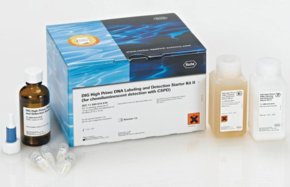
|

| 产地 | 中国 |
| 保存条件 | -20°C |
| 品牌 | roche |
| 货号 | 11581074001 |
| 用途 | 核酸分离、检测 |
| 包装规格 | 500 μg |
| 纯度 | % |
| CAS编号 | |
| 保质期 | |
| 是否进口 | 否 |
即日起至9月30日,精选Roche畅销产品大促!
Repetitive elements (IRS) present in a probe (e.g., cosmids, YACs, chromosome painting probes) generate nonspecific hybridization signals that are distributed over the whole chromosome or genome. To enable specific hybridization of the probe to the chromosomal target site (e.g., single-copy sequences or low-copy repeats) the probe must be denatured in the presence of excess unlabeled COT Human DNA. This DNA serves as a competitor. In a subsequent preannealing step, the repetitive probe elements rapidly hybridize to excess repeats in the COT Human DNA, while most of the specific probe sequences remain single-stranded and thus can be hybridized to their chromosomal targets. This technique is known as chromosomal in situ suppression (CISS) hybridization.
The COT fraction of human genomic DNA consists largely of rapidly annealing repetitive elements. These interspersed repetitive sequences (IRS) such as SINEs (small interspersed repetitive elements, e.g., Alu-elements) and LINEs (large interspersed repetitive elements, e.g., L1-elements) are distributed ubiquitously throughout the genome. COT Human DNA is prepared from human placental DNA by shearing, denaturing, and reannealing under conditions that enrich these repetitive elements.
COT Human DNA is used in chromosome in situ suppression (CISS) hybridization. Cosmid or YAC probes contain repetitive elements that result in monospecific hybridization signals distributed over the entire chromosome. To enable specific hybridization to the chromosomal target site, the probe is denatured together with an excess of unlabeled COT Human DNA as a competitor. COT Human DNA can be used to suppress nonspecific hybridization to human repetitive sequences in microarray analysis, and in filter and in fluorescent in situ hybridization experiments.
In agarose gel electrophoresis the length distribution of the COT Human DNA fragments shows a maximum in the range of 50 to 300 nucleotides.
Solution, 1 mg/ml, 10 mM Tris-HCl, 1 mM EDTA, pH 7.4
仅用于生命科学研究。不可用于诊断。